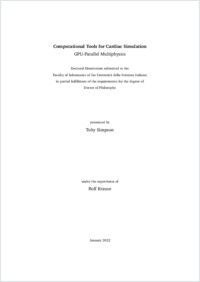Computational tools for cardiac simulation : GPU-parallel multiphysics
- Simpson, Toby
- Krause, Rolf (Degree supervisor)
- 2022
PhD: Università della Svizzera italiana
Cardiac simulation
Finite volume method
Gpu
Graphics processing unit
Finite strain theory
Fluid dynamics
Fluid-structure interaction
English
Cardiovascular disease affects millions of people worldwide and its social and economic cost clearly motivates scientific research. Computer simulation can lead to a better understanding of cardiac physiology, and for pathology presents opportunities for low-cost and low-risk design and testing of therapies, including surgical and pharmacological intervention as well as automated diagnosis and screening. Currently, the simulation of a whole heart model, including the interaction of electrophysiology, solid mechanics and fluid dynamics is the subject of ongoing research in computational science. Typically, the computation of a single heart- beat requires many processor hours on a supercomputer. The financial and ultimately environmental cost of such a computation prevents it from becoming a viable clinical or research solution. We re-formulate the standard mathematical models of continuum mechanics, such as the Bidomain Model, Finite Strain Theory and the Navier-Stokes Equations, specifically for parallel processing and show proof-of-concept of a computational approach that can generate a complete description of a human heart- beat on a single Graphics Processing Unit (GPU) within a few minutes. The approach is based on a Finite Volume Method (FVM) discretisation which is both matrix- and mesh-free, ideally suited to voxel-based medical imaging data. The solution of nonlinear ordinary and partial differential equations proceeds via the method of lines and operator-splitting. The resulting algorithm is implemented in the OpenCL standard and can run on almost any platform. It does not perform any CPU processing and has no dependence on third-party software libraries. The implementation is simple and computationally cheap enough to be used as the kernel of more complex software. Used iteratively and in parallel across an array of GPUs, it would allow movement through a solution space of parameterised hearts in optimisation problems for parameter estimation, patient- specific fitting, or in the training of Artificial Neural Networks (ANN). The algorithm presents new opportunities in research and clinical practice and is readily extensible as a simulation tool for a broad range of multiphysics problems.
- Collections
- Language
-
- English
- Classification
- Computer science and technology
- License
-
License undefined
- Open access status
- green
- Identifiers
-
- NDP-USI 2022INF012
- URN urn:nbn:ch:rero-006-120320
- ARK ark:/12658/srd1324964
- Persistent URL
- https://n2t.net/ark:/12658/srd1324964
Statistics
Document views: 196
File downloads:
- 2022INF012: 127
